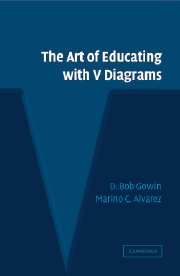Book contents
- Frontmatter
- Contents
- Foreword
- Preface
- Acknowledgment
- PART ONE FOUR COMMONPLACES OF EDUCATING PLUS ONE
- PART TWO THE V DIAGRAM
- 3 Thinking Around the V
- 4 Structuring Knowledge
- 5 Minding Events and Making a V
- 6 Learning and Teaching the V
- Part 2 Summary
- PART THREE ANALYZING, EVALUATING, AND CONDUCTING RESEARCH
- PART FOUR REASONING WITH TECHNOLOGY
- Part 4 Summary
- Epilogue
- Appendices
- Bibliography
- Name Index
- Subject Index
5 - Minding Events and Making a V
Published online by Cambridge University Press: 19 November 2009
- Frontmatter
- Contents
- Foreword
- Preface
- Acknowledgment
- PART ONE FOUR COMMONPLACES OF EDUCATING PLUS ONE
- PART TWO THE V DIAGRAM
- 3 Thinking Around the V
- 4 Structuring Knowledge
- 5 Minding Events and Making a V
- 6 Learning and Teaching the V
- Part 2 Summary
- PART THREE ANALYZING, EVALUATING, AND CONDUCTING RESEARCH
- PART FOUR REASONING WITH TECHNOLOGY
- Part 4 Summary
- Epilogue
- Appendices
- Bibliography
- Name Index
- Subject Index
Summary
Principle 5. AVrepresents knowledge of an educative event formed by human agents interacting in a social setting where the reality of the social constructions vary in complex ways. TheVsimplifies this complexity.
A lot of thinking is required to make a V. It is not easy. The V forces you to look at events. It forces you to think, to pay attention to happenings not totally under your control. Minding educative events is like minding the children, or minding the store. The mind is active connecting past knowledge to present events. Surprises occur. Plans change. It takes knowledge to figure out what's going on. We use our knowledge of past events to help interpret new events.
Minding past knowledge takes time, a lot of time – months and years. Typically a four-year college degree is required for individuals who desire to become teachers. Unfortunately, the typical supply of undergraduate knowledge is not presented with V diagrams in mind. Teachers in action use whatever knowledge they can find to present new educative events. Their first requirement is to figure out what they already know. Next, they need to lay the V on this prior knowledge; again, not an easy task.
The V is a thinking tool that requires more than just a “make it and take it” form of preparation.
- Type
- Chapter
- Information
- The Art of Educating with V Diagrams , pp. 62 - 74Publisher: Cambridge University PressPrint publication year: 2005



